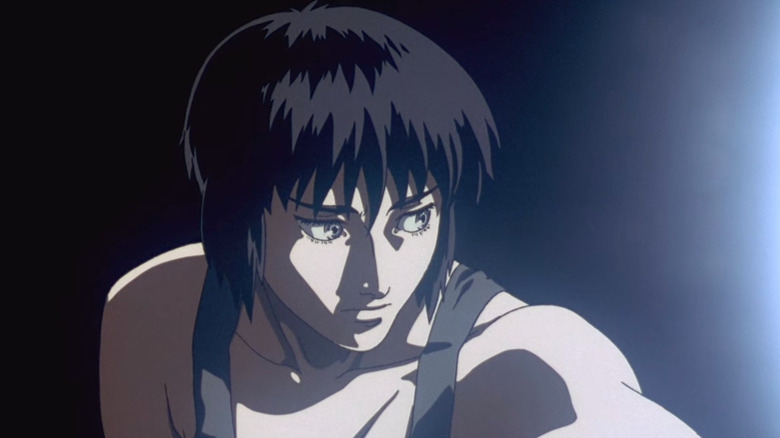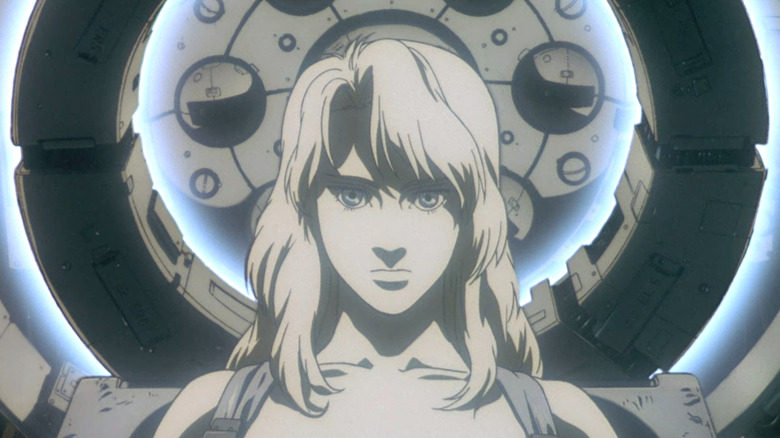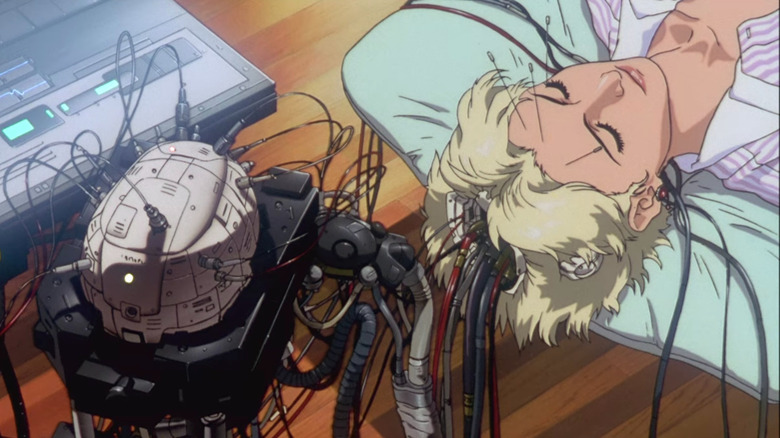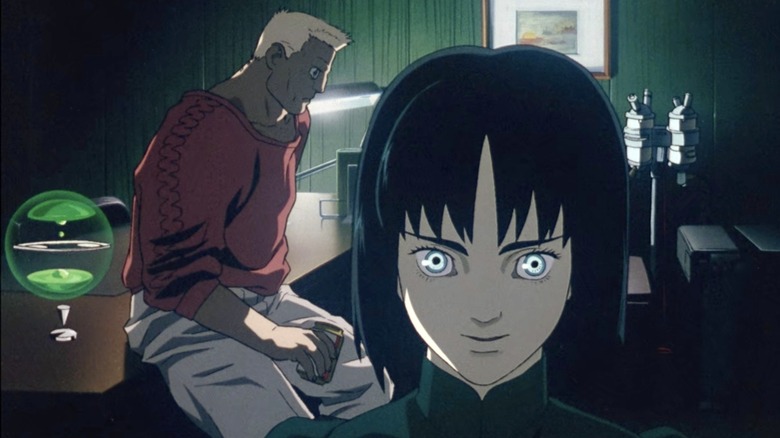Ghost In The Shell Ending Explained: The Next Stage Of Post-Human Evolution
This post contains spoilers for the ending of "Ghost in the Shell."
At least twice throughout its 82-minute runtime, Mamoru Oshii's 1995 anime film adaptation of "Ghost in the Shell" quotes from a biblical passage. On a boat in the fictional New Port City circa 2029, Major Motoko Kusanagi, voiced by Atsuko Tanaka in Japanese and Mimi Woods in the English dubbing, hears a whisper from her "ghost" and says, "For now, we see through a glass, darkly." This same line is referenced in the title of "A Scanner Darkly," with that book's author, Philip K. Dick, having penned the source material for "Blade Runner," a notable influence on "Ghost in the Shell." (Though set in Japan, New Port City more resembles Hong Kong, which inspired the look of both films. The key word "replicant" also appears.)
Toward the end of the movie, Kusanagi quotes again from the passage in 1 Corinthians more at length, saying, "When I was a child, I spake as a child, I understood as a child, I thought as a child. But when I became a man, I put away childish things." The irony is, "Ghost in the Shell" ends the opposite way, with Kusanagi becoming a child and putting away adult things (namely, her cyborg body parts, some of which she's ripped off, or which snipers have blown off, after her climactic confrontation with a spider tank).
So, what are we to make of Kusanagi becoming an even younger, doll-eyed cyborg in "Ghost in the Shell?" The movie's chase scenes and action set pieces belie a deeper meditative quality, and it has an ending that might really fry your cyber-brain, especially if you're trying to parse the sci-fi technobabble through subtitles while keeping one eye on the arresting imagery.
Enter the Puppet Master
Based on Masamune Shirow's 1989 manga series, "Ghost in the Shell" puts Kusanagi and her partner Batou on the trail of a phantom hacker dubbed the Puppet Master. Described as "the most unique hacker in the history of cyber-brain crime," the Puppet Master uses phone lines to "ghost-hack" people and get them to carry out offenses. In the cyberpunk future "Ghost in the Shell" envisions, people's brains are encased in hardware that enables them to access the internet — and, in turn, be accessed and controlled from outside.
One of the Puppet Master's victims is a garbage man who has fake memories of a family that doesn't exist implanted in his mind. Things like this are a "violation of cyber-brain policy," we're told, but they go along with the Puppet Master's original programming.
After the Puppet Master's ghost, or consciousness, is trapped in a new cyborg shell at Megatech Body (the same company that manufactured Kusanagi's current form), we learn its true nature as Project 2501, "a life form that was born in the sea of information." While Kusanagi is an agent of Section 9, another Public Security department, Section 6, created Project 2501 as a tool for industrial espionage and data manipulation.
Kusanagi's boss thinks the Puppet Master is human and has left his real body a lifeless husk somewhere, now that he's stranded in this new one at Megatech. But as the Puppet Master explains, "There will be no corpse, because until now, there was never a body." It's not a man; it's a machine, a computer brain that became self-aware as it "wandered the various networks" and took a special interest in Kusanagi, a fully cyborg individual with whom it had something in common.
Post-human, pre-Matrix
"Ghost in the Shell" influenced "The Matrix," and you can definitely see echoes of it across that film's acupuncture needles, green lines of code (or digital "Matrix" rain), and images of people jacking into a neural network via plugs on the backs of their necks. In "The Matrix Reloaded," there's also the recurring image of a gun-toting woman falling backward through the air from a skyscraper window.
Kusanagi, like the Puppet Master, is post-human: someone whose body is a "full-replacement" shell. Her ghost, which the movie likens to a soul using the Japanese word tamashii, has been inserted into a new cyborg frame, leaving her disconnected from her former self. Throughout the movie, this leaves her in a state of ontological uncertainty, questioning the very nature of her own being with statements like, "the real me died a long time ago," and, "Maybe there was never a real 'me' to begin with."
It also means traditional concepts of gender and race maybe no longer apply to Kusanagi. This is something the live-action remake of "Ghost in the Shell," starring Scarlet Johannson, would explore further with its controversial plot involving a Japanese woman in a white woman's body. In the anime Kusanagi, we see the potential for the trans allegory that "The Matrix" would later become for writer-directors Lana and Lilly Wachowski.
Though "Ghost in the Shell" has some typical, scopophilic moments of fan-service nudity, having Kusanagi strip down naked when she activates her thermoptic camouflage and turns invisible isn't just about fetishizing women's bodies. As she struggles to lift the lid off the spider tank, every muscle in Kusanagi's mechanical body bulges, making her look more masculine, like a weightlifter, and thereby complicating the sexualization of her as an object of feminine desire.
Neither the Puppet Master nor the Major
Project 2501/the Puppet Master is the answer to the question, "What if a computer brain could generate a ghost and harbor a soul?" As it lobbies for political asylum as an autonomous new life form, it argues that human memories are as good as fantasy and that, "the DNA you carry is nothing more than a self-preserving program itself." If the garbage man can be rewired with the virtual dream of a family, who's to say anyone's memories are real?
Though a virus would pose a threat to the Puppet Master, it lacks true humanity in that it can't die naturally or beget unique children. It can only copy itself, so it wants to prevent its own extinction by merging with Kusanagi and bearing "offspring into the net itself." This it manages to do before Section 6's snipers destroy both their bodies.
Luckily, Batou is able to save Kusanagi's cyber-brain and outfit it with a new child-sized cyborg shell that he got on the black market. He explains that the Puppet Master case has been covered up as the work of a terrorist and that it "ended in a draw" between Section 9 and Section 6. Meanwhile, Kusanagi has been reborn into a new body, her voice now gravitating between a child's and her old recognizable adult voice.
"Here before you is neither the program called the Puppet Master, nor the woman that was called the Major," she tells Batou. As the credits roll and composer Kenji Kawai's score gives way to U2 and Brian Eno's "One Minute Warning," the audience has witnessed the next stage of post-human evolution, while Kusanagi and the Puppet Master's daughter is left to look out over the city, pondering where she might go in the "vast and limitless" net.



